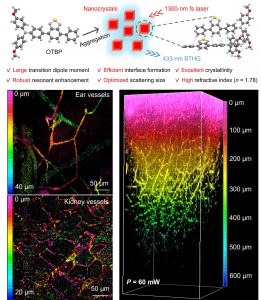A research team led by Associate Professor Liu Tzu-Ming and Research Assistant Professor Xu Changhuo in the Faculty of Health Sciences (FHS) at the University of Macau (UM), in collaboration with a team led by Distinguished Visiting Professor Tang Ben Zhong and Research Professor Lam Wing Yip at the Hong Kong University of Science and Technology (HKUST), has made significant progress in deep-brain angiography. The team has successfully optimised nonlinear optical (NLO) imaging technology to capture high-resolution images of the deep-brain vasculature (up to 500μm) using extremely low laser power. This significantly reduces the risk of photodamage during diagnostic procedures. This breakthrough offers a new approach to the early screening of subclinical cerebrovascular diseases, such as microaneurysms. The research has been published in the prestigious international journal Advanced Materials.
Theodore H. Maiman invented the first ruby laser in 1960, marking the dawn of laser technology. Scientists later discovered that when lasers interact with quartz crystals, a series of NLO phenomena occur. Among these, third-harmonic generation (THG) has drawn significant attention due to its signal enhancement properties at interfaces. THG is a four-wave mixing process that can convert 1,300nm incident light to a 433nm THG output signal. This technology is widely used for label-free imaging of biological tissue owing to its high tissue penetration depth and detection sensitivity. However, traditional THG materials have several limitations, including low efficiency, the difficulty of collecting backward signals, and poor biocompatibility. These limitations hinder their application in brain science. Furthermore, increasing the laser power to achieve satisfactory backward THG (BTHG) output can cause irreversible photodamage to tissue, which has long hindered progress in in vivo imaging research. Achieving a balance between efficiency and safety remains a critical challenge in the field.
To address these limitations, the research team designed a series of organic small-molecule probes. By optimising the molecular packing of π-electron and controlling the mesoscale morphology, the team identified an efficient THG probe named ‘OTBP’. Results demonstrated that OTBP self-assembled into stable nanocrystals with a high refractive index (n=1.78), significantly enhancing BTHG signal output. Under low-power laser excitation (60mW, pulse energy 0.75nJ), the technology achieved high-contrast imaging of deep-brain vasculature (500μm) in mice. This enabled the visualisation of microvessels as small as 6.8μm in diameter, with a signal-to-noise ratio of 143. Compared to traditional CT and MRI angiography, this new technology offers high resolution and minimal invasiveness. It can address the issue of low resolution in conventional methods and complement existing angiography techniques. The technology also shows promise in the early detection of conditions such as stroke and aneurysms, advancing the development of minimally invasive diagnostics.
The corresponding authors of the study are Liu Tzu-Ming Liu, Xu Changhuo, Lam Wing Yip, and Tang Ben Zhong. The co-first authors are Du Lidong, a doctoral student from UM FHS, and Shen Hanchen, a doctoral graduate from HKUST. UM doctoral students Zhou Qingqing and Ye Xuhao, along with other team members also made significant contributions to the study. The research was funded by the Science and Technology Development Fund of the Macao SAR (File No.: 0049/2023/ITP2, 0003/2023/RIC, 0013/2023/RIC). The full version of the research article is available at: https://advanced.onlinelibrary.wiley.com/doi/full/10.1002/adma.202414419.
| Source: Faculty of Health Sciences | |
| Media Contact Information: | |
| Communications Office, University of Macau | |
| Albee Lei | Tel: (853) 8822 8004 |
| Bell Leong | Tel: (853) 8822 8009 |
| Email: | prs.media@um.edu.mo |



